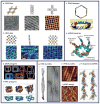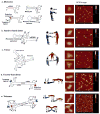The emerging field of RNA nanotechnology
- PMID: 21102465
- PMCID: PMC3149862
- DOI: 10.1038/nnano.2010.231
The emerging field of RNA nanotechnology
Abstract
Like DNA, RNA can be designed and manipulated to produce a variety of different nanostructures. Moreover, RNA has a flexible structure and possesses catalytic functions that are similar to proteins. Although RNA nanotechnology resembles DNA nanotechnology in many ways, the base-pairing rules for constructing nanoparticles are different. The large variety of loops and motifs found in RNA allows it to fold into numerous complicated structures, and this diversity provides a platform for identifying viable building blocks for various applications. The thermal stability of RNA also allows the production of multivalent nanostructures with defined stoichiometry. Here we review techniques for constructing RNA nanoparticles from different building blocks, we describe the distinct attributes of RNA inside the body, and discuss potential applications of RNA nanostructures in medicine. We also offer some perspectives on the yield and cost of RNA production.
Figures



References
-
- Aldaye FA, Palmer AL, Sleiman HF. Assembling materials with DNA as the guide. Science. 2008;321:1795–1799. - PubMed
Publication types
MeSH terms
Substances
Grants and funding
LinkOut - more resources
Full Text Sources
Other Literature Sources

